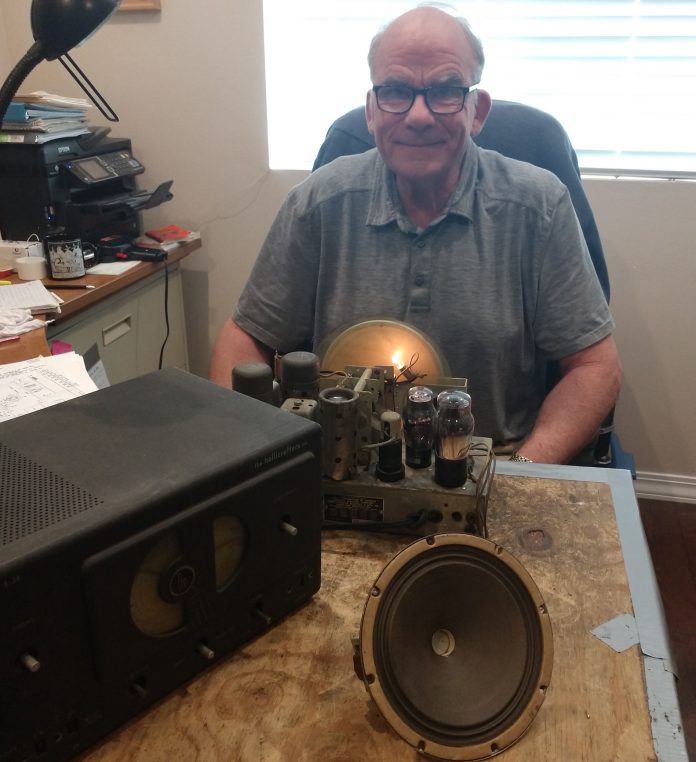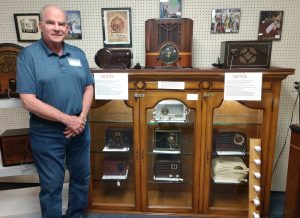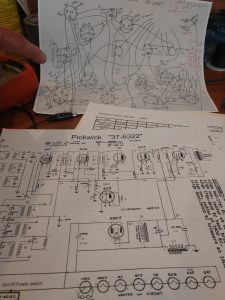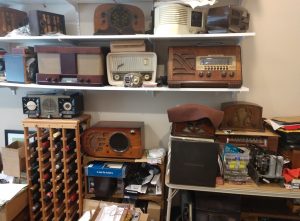
When Bob Donner finally got around to restoring the radio his grandfather had given him, he entered a world previously unknown to him. It was a time when radios were the center of the universe. During the 1930s, the radio was a featured piece of furniture in people’s homes. “At the start of the decade, 12 million American households owned a radio, and by 1939 this total had exploded to more than 28 million,” according to PBS.
 As Bob explored the internet for parts, he found the woodworking and styles of vintage radio cabinets were beautiful. “It hooked me,” Bob says. An innocent foray to restore one family radio that he inherited when he was 13 has turned into a full-fledged hobby that utilizes Bob’s engineering background. Adding a big dose of patience with artistic inclinations, he services the radios to working condition and lovingly restores the cabinets.
As Bob explored the internet for parts, he found the woodworking and styles of vintage radio cabinets were beautiful. “It hooked me,” Bob says. An innocent foray to restore one family radio that he inherited when he was 13 has turned into a full-fledged hobby that utilizes Bob’s engineering background. Adding a big dose of patience with artistic inclinations, he services the radios to working condition and lovingly restores the cabinets.
“I’m not an expert,” emphasizes Bob. He just likes to do it. It’s a marriage of science and art, which suits him well. Initially Bob looks at the chassis, that’s what is inside the cabinet and what makes the sounds. He draws a schematic. Then he downloads the schematic from the internet of what it is supposed to look like. Some old radios have been tinkered with by previous owners, who may or may not have known what they were doing. An accurate and proper schematic is beauty to an engineering brain, but a jumble of lines and shapes to others. “I look at it as a system,” says Bob, who likes solving the mysteries. He can talk about superheterodynes and TRF’s, which are receivers, if you are interested.

Bob finds cabinets on Craigslist or Offer Up. He sometimes has luck at garage sales or scouting out antique stores. “If I like the way a cabinet looks, I buy it,” says Bob adding, “I assume the radio does not work.” The shelves in his office and workspace are lined with radios in various stages of getting to the finish line. One is waiting for a tube. Another for matching grill material (that’s the cloth that goes behind the openings in the front of the cabinet where the sound comes out.) He can tell you the details of each one as if they are old friends.
One of the first radios he worked on was a Western Air Patrol 5. Half of the project is getting the radio to work. The other half is restoring the cabinet. “My goal is to keep it as original as possible,” explains Bob, so in refinishing, he wants to keep as much original material in place as he can. The finished product, in its original glory, is an honor to its past. Some radios were small and meant to be on a table. Others are freestanding pieces of furniture. “I haven’t seen the same radio twice,” says Bob who notices subtle variations both inside and out.

Every radio that Bob restores and refinishes comes with a page or two of detailed information including its country of origin, manufacturer or brand, age, wave bands, tube types, etc. and all the work he has complete. You can view a display of Bob’s radios at Lighthouse Antiques and Crafts Mall. The radios are there all the time. Bob is on-site for two shifts a month and would be happy to talk radios.
If you have not been to Lighthouse Antiques lately or ever, it’s a treasure. Over 100 dealers have space with artwork, vintage clothes, glassware, jewelry and that’s just the beginning. It’s fun to poke around. Inventory there is sure to bring up memories, like plates from childhood or memorabilia. I found myself smiling numerous times. The space is bigger than you might imagine, and the variety is impressive.
Here’s a tip from Bob. “Don’t plug in old radios,” he warns. The parts are old and deteriorate. The surge of power could create a short circuit, which could cause a fire and do more damage to the components.

Check out Bob’s favorite radio station, listener supported KBRD 680. “Whether you like piano rolls, pre-1920 cylinders, 78s from the 20s, 30s, 40s and 50s or early 45s and mono LP’s, this is your station,” says the KBIRD webpage. “You probably won’t hear the same song twice,” notes Bob.
Once you get your radio situated at home, turn it on, tune it in and enjoy. You might not be hearing one of FDR’s fireside chats or the latest episode of the “Lone Ranger,” but you can listen to music and let your imagination go free. Bob has one of his radios on!
If you have a radio question and don’t catch Bob at Lighthouse Antiques, you can send him at email at Bob@Donner.com.


















































